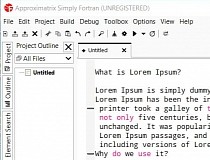
- #Simply fortran appgraphics how to#
- #Simply fortran appgraphics full#
- #Simply fortran appgraphics code#
i'd like to release this project (fully functional) in less than 10 year if i can.
#Simply fortran appgraphics code#
It will be on github, i'm not really looking for code contributors (i really want to code it).
#Simply fortran appgraphics full#
emulate a full computer on top of this extended cpu, add an os, add an interpreter. Then take this existing cpu and extend it at will. why should i bother with this ?Īctually, i'd like to fully emulate an existing CPU (just the cpu, not a full computer), validate that it works as intended. But dealing with this mixed 16/32bit stuff. The 68k certainly is a nice real-world cpu.

Or even write some stuff in C for problem that can't easily be dealt by fortran.

Fortran is not really asynchronous-friendly. I see some problems already but i saw some solution too : Here i am ! i'd like your input (pretty please?) on this project. But fortran wasn't that easy to learn with weird syntax and punch card limitations. BASIC was designed in the same era, and heavily patterned on Fortran.
#Simply fortran appgraphics how to#
) will just be hardcoded cpu instruction. How to use PGPLOT Graphics with Fortran95 on Windows ®. a simple architecture (eg : the screen is just memory mapped somewhere and pfft, problem solved).Find a good CPU architecture, extend it with whatever cross my mind (fpu, complex math opcode (i love fractals), as many register as i want with as many bit i wish.So, here i am, friendly OSdevers, with a project : it's not as if i wanted to build it using logic gate (any logisim fan?) Bigger registers, more memory, more cpu intensive for the emulator, but no biggies. making (virtually) a 256 bit Z80 is just as easy as making a 8 bit one. emulating a cpu, if we get rid of timing constraint, it's not that hard.Īnd, designing one, as long as you're not constrained by real hardware world problem, is not really that difficult either. AppGraphics provides low-level drawing primitives, text output, printing and image saving support, and Windows components, including menus, buttons, and text entries. A Z80 ? a 6809 ? (both well known and documented). All versions of Simply Fortran include AppGraphics, a toolkit for programming graphics and graphical user interfaces from Fortran.

Let's create a computer that doesn't exist to get rid of this compatibility problem and just emulate a chosen existing cpu and. hardware device, timing, making it compatible, will be a massive pain to do it. Hum, but what should i emulate ? I really like the IBM 7090 but it's massive, complex, and i don't really know it that well and there are some massively terrible stuff like this whole BCD math.


 0 kommentar(er)
0 kommentar(er)
